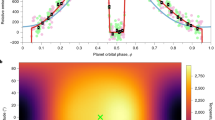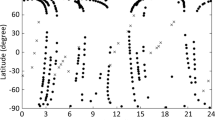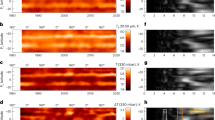Abstract
DURING the exploration of the planet Venus by the Soviet space probe Venera 9, we measured the quantity of hydrogen in the upper atmosphere and its temperature through the optical observation of far UV atmospheric emission. The temperature at the altitude of 250 km (the upper boundary of the atmosphere) was found to vary from 500 K on the dayside to 200 K on the nightside. This variation is compatible with our current knowledge of the heating of upper atmosphere by the solar radiation. It is shown here that this variation, which is larger than on Earth, induces an exospheric transport (out of the atmosphere) of hydrogen from the dayside to the nightside. As an indirect consequence, this transport allows the existence of a large quantity of atomic oxygen in the upper atmosphere, a feature which was still controversial.
This is a preview of subscription content, access via your institution
Access options
Subscribe to this journal
Receive 51 print issues and online access
$199.00 per year
only $3.90 per issue
Buy this article
- Purchase on Springer Link
- Instant access to full article PDF
Prices may be subject to local taxes which are calculated during checkout
Similar content being viewed by others
References
Chamberlain, J. W. Planet. Space Sci. 11, 901 (1963).
Liu, S. C. & Donahue, T. M. J. atmos. Sci. 31, 1118 (1974).
Hunten, D. M. & Strobell, D. J. atmos. Sci. 31, 305–17 (1974).
Bertaux, J. L. et al. Planet. Space Sci. 26, 817 (1978).
Bertaux, J. L. et al. Astr. Astrophys. 46, 19 (1976).
Thomas, G. E. J. geophys. Res. 80, 2247 (1975).
Blamont, J. E., Cazes, S. & Emerich, C. J. geophys. Res. 80, 2247 (1975).
Marcelin, M. thesis Univ. Paris VII (1978).
Broadfoot, A. L., Kumar, S., Belton, M. J. S. & McElroy, M. B. Science 183, 1315 (1974).
Liu, S. C. & Donahue, T. M. Icarus 24, 148 (1975).
Sze, N. D. & McElroy, M. B. Planet. Space Sci. 23, 763 (1975).
Anderson, D. E. J. geophys. Res. 81, 1213 (1976).
Dickinson, R. E. & Ridley, E. C. Icarus 30, 163 (1977).
Author information
Authors and Affiliations
Rights and permissions
About this article
Cite this article
BERTAUX, J., BLAMONT, J., MARCELIN, M. et al. Consequences of the day-to-night variation of the exospheric temperature of Venus. Nature 277, 546–548 (1979). https://doi.org/10.1038/277546a0
Received:
Accepted:
Published:
Issue Date:
DOI: https://doi.org/10.1038/277546a0
Comments
By submitting a comment you agree to abide by our Terms and Community Guidelines. If you find something abusive or that does not comply with our terms or guidelines please flag it as inappropriate.



